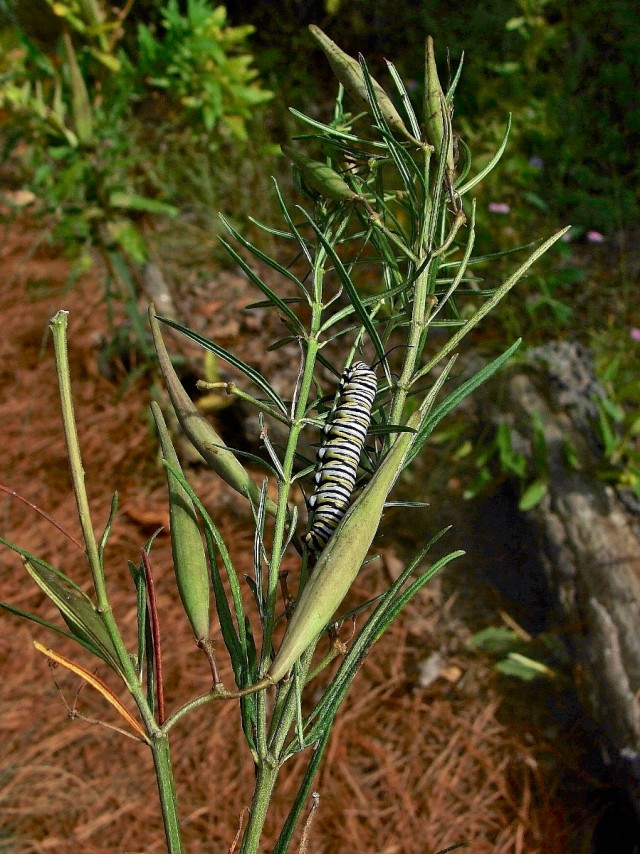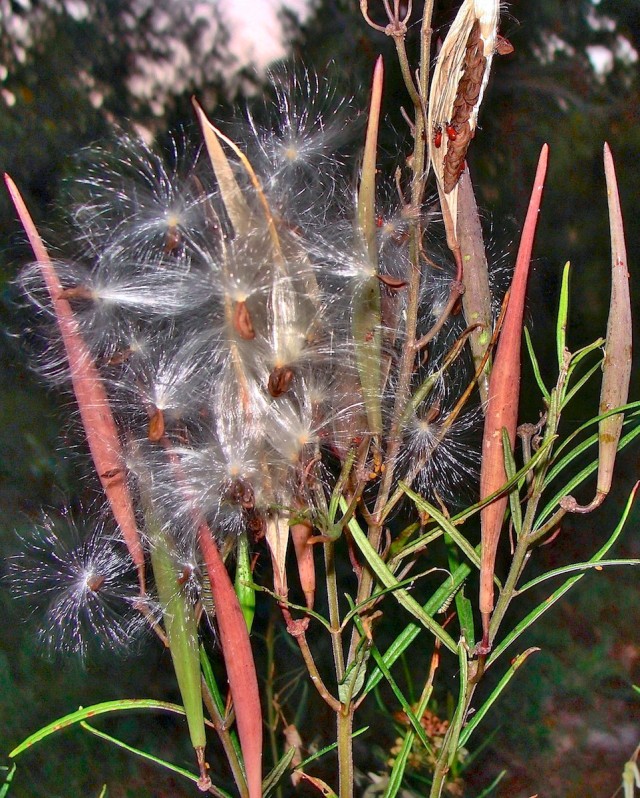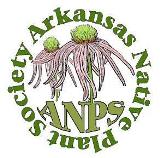Whorled Milkweed (Asclepias verticillata) in the Dogbane (Apocynaceae) family, formerly in the Milkweed (Asclepiadaceae) family, is a perennial herbaceous forb. The genus name relates to the Greek god of medicine (Asklepios, alternatively spelled Asclepius). The specific epithet is from a Latin word meaning “whorled”, in reference to the plant’s leaf arrangement. Whorled milkweed, a widely spread species, occurs from Arizona to Montana thence east to the Atlantic and Gulf coasts (but absent from Utah and Colorado as well as Maine and New Hampshire). It is found throughout much of Arkansas, except for portions of the Mississippi Alluvial Plain. Preferred habitat is sunny prairies and glades or partially sunny open woods and woodland borders, with soils sandy to limy, ranging from dry and rocky to well drained but moist.
Whorled milkweed typically occurs as solitary plants in areas not dominated by larger species. It has one to several erect, straight, slender, and terete stems that are 2 or more feet tall. Stems, light to medium green, contain white sap, as is typical of most milkweeds. Cross-sectional stem diameter decreases very gradually from ground level, where a diameter of ⅛ to ¼ inch is typical, into the inflorescence. Stems may be glabrous or puberulent (minutely pubescent) along longitudinal lines. A few secondary stems, with the same growth pattern as main stems, may grow from upper leaf whorls of more vigorous plants or after a stem has been nipped. Stems die back to the ground at the end of the growth year, but lower portions remain erect and hardened well into the following year. Plants are resistant to drought.
Whorls of leaves, which occur along the entire stem, are more widely spaced about mid-stem, with decreasing spacing toward base and apex. Space between whorls may be ½ inch in the lower portion and 1¼ inches in the mid-portion. Leaf whorls consist of three to eight very narrow, long and thin leaves with tapered tips and rounded, sessile bases. Leaves are up to 1¾ or more inches long and 1/16 inch wide with longest leaves about mid-stem, the leaf length and number decreasing into the inflorescence. Leaves of a leaf whorl are mostly in the same plane, but some whorls are slightly off-plane and an isolated leaf may occur between whorls. Leaves, mostly glabrous, are a medium to dark green above and paler beneath. Leaf bases and swollen nodes are also a lighter green. The base of a leaf is ascending with the remainder of the leaf trending horizontally or slightly descending. Margins are entire and tightly rolled downward (revolute) so that a leaf feels thicker than it really is. Other than a slightly recessed midvein above, leaf venation is obscure. Like the stems, the leaves contain a white sap. Lower leaves drop off with dry soil conditions.
 Photo 1: Leaves in a whorl may not necessarily all lie in a single plane (they may be staggered slightly). Note puberulent longitudinal lines along stem.
Photo 1: Leaves in a whorl may not necessarily all lie in a single plane (they may be staggered slightly). Note puberulent longitudinal lines along stem.
Inflorescences consists of a few to a dozen umbels along the upper portion of the main and secondary stems. Umbels have up to about twenty flowers each. All leaf whorls within the inflorescence zone tend to produce one to several umbels. Umbels may have an overall light green color or, in sunnier sites, have a reddish shading, especially evident on petals. Peduncles, growing from stems at a sharper angle than adjoining leaves (ascending at about 45 degrees), are straight and up to 1½ inches long. Pedicels, also straight, have a length of up to ¾ inch. Blooming sequence of the umbels progresses from lowermost to uppermost, the bloom period extending often over a month or more in larger plants. An umbel in bloom may be up to 1½ inches across, depending on the number of flowers. Small, narrowly linear bracts occur at the base of the umbels, fading as the umbels mature. Peduncles and pedicels are terete and may be puberulent.
Inflorescence becomes evident in late spring after stems have attained most of their eventual height. When they first appear, the umbels comprise tight clusters of round-topped buds, each shaped by five corolla lobes already free of their very small calyxes. Buds may be a light green or, in sunnier sites, reddish brown.
 Photo 2: In this mid-May photo, these lower umbels are mostly in bud, with a few flowers at anthesis. Note reddish coloration, linear bracts at base of umbels and lighter green lower mid-vein of leaves on the left.
Photo 2: In this mid-May photo, these lower umbels are mostly in bud, with a few flowers at anthesis. Note reddish coloration, linear bracts at base of umbels and lighter green lower mid-vein of leaves on the left.
 Photo 3: Umbels of this 30-inch-tall, two-stemmed plant vary from being in full bloom to those in early development (as seen at top edge of photo).
Photo 3: Umbels of this 30-inch-tall, two-stemmed plant vary from being in full bloom to those in early development (as seen at top edge of photo).
With anthesis, small flowers on straight, slender, ⅓-inch pedicels are about ¼ inch long. Each corolla is composed of a short tube bearing five cupped, sharply reflexed, linear-ovoid lobes of the same coloration as the flower was in bud. The corona is composed of five elevated white hoods (nectar chambers) with prominent, protruding, inward-pointing white horns. Staminal filaments are fused into a tube called the column, while the anthers and stigmas are fused into a unique, head-like structure, the gynostegium. Flowers are set in a deeply divided calyx of five lanceolate lobes that are 1/4 the length of the corolla. Other than possible reddish coloration on the corolla lobes, flowers are whitish to light green.
Details regarding the complex pollination process of milkweeds may be found in an article about red-ring milkweed.
 Photo 4: Details of the flowers’ coloration (from a sunny site): corolla lobes and coronal hoods and horns can be seen.
Photo 4: Details of the flowers’ coloration (from a sunny site): corolla lobes and coronal hoods and horns can be seen.
Ovaries of some of the fertilized flowers develop into erect or ascending, smooth, long, narrow and pointed pods that are from 3 to 4 inches long and ½ inch wide. When pods (follicles) are mature and dry, they split along a longitudinal seam to expose a number of flat, ovate, brown seeds pressed together at the base of the pod. Seeds have many white, silky, filament-like hairs attached at their apices which fill the remainder of the pod. As the pod splits, winds pull seeds out by tugging on the long hairs and wing-tissue along the edge of the seeds.
 Photo 5: In fall, pods approach maturity and plants provide a food source for monarch caterpillars. Revolute leaf margins are evident on the brown leaf at lower left.
Photo 5: In fall, pods approach maturity and plants provide a food source for monarch caterpillars. Revolute leaf margins are evident on the brown leaf at lower left.
 Photo 6: Mature seeds with apical hairs are dispersed from pods by the wind. Two young monarch caterpillars can be seen.
Photo 6: Mature seeds with apical hairs are dispersed from pods by the wind. Two young monarch caterpillars can be seen.
Whorled milkweed, in comparison with most other native milkweeds, has a small stature that does not attract immediate attention in a garden or woodland setting. However, it is an important plant for insects (including monarch caterpillars) that is fairly easy to establish from seed and does not become invasive. It is not favored by deer and is resistant to drought.
Fourteen species of milkweed in the genus Asclepias occur in Arkansas. With its narrow, linear and mostly whorled leaves, whorled milkweed is easily distinguished from the other milkweeds, with perhaps the exception of narrow-leaf milkweed (Asclepias stenophylla) which is known from only a couple of north-border counties. Narrow-leaf milkweed also has narrow, linear leaves and whitish flowers; however, its leaves are alternate to nearly opposite and its greenish flower umbels are nearly sessile.
Article and photographs by ANPS member Sid Vogelpohl


Pingback: Know Your Natives – Butterfly Weed | Arkansas Native Plant Society